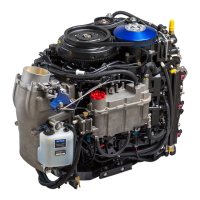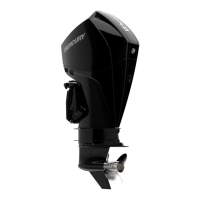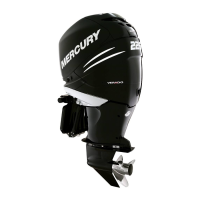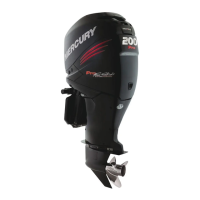Shift Control
a - Shift actuator connector
b - PCM connector B
c - PCM connector C
Connector Pin Wire Color Function PCM
1 Black Shift actuator B CH3
2 Green Shift position 1 BK1
3 Purple/yellow Sensor power A (+) CF1
4 Red/purple Shift actuator A CH4
5 Black/orange Sensor ground A (–) CE1
6 Pink Shift position 2 BC1
Shift Actuator Troubleshooting
Before attempting to diagnose the shift actuator on an engine that does not shift, ensure that the PCM is receiving the shift
signal from the helm control. On DTS engines, this would include the electronic remote control (ERC), command module, and
CAN circuits. On mechanical engines, this would include the remote control, shift cable, and the shift demand sensor. Use CDS
G3 Live Data to ensure that the PCM is receiving the proper shift signal.
Any malfunction of the shift actuator will likely cause a fault to be set in the PCM. Use CDS G3 to read all active faults and
diagnose according to the descriptions in Section 4A ‑ Fault Codes.
The output of the two shift position sensors can be viewed in CDS G3 Live Data. The sensors should be in the range of values
shown below during the specified shift position:
• Forward: 750–965 ADC
• Neutral: 465–550 ADC
• Reverse: 60–275 ADC
NOTE: The sensors should not differ more than 50 ADC from each other in any given shift position.
If the shift actuator does not perform correctly, use the preceding Shift Control circuit diagram to inspect the connections and
perform a continuity check of the wires back to the PCM connectors. The shift actuator does not have any internal serviceable
components.
PCM Shift Actuator Circuit Test
Refer to the following illustration for the PCM shift actuator circuit test.
100A
101
PPL/YEL
BLK/ORN
GRN
GRN
BLK
BLK
RED/PPL
BLK/ORN
PNK
PNK
PPL/YEL
RED/PPL
1
2
3
4
5
6
H4
E1
F1
H3
A1
K1
M4
A1
C1
4
5
6
1
2
3
A B
C
D E F G H
J
K
AB
C
DEFGH
J
K
1
3
2
4
L
M
L
M
Actuators and Relays
90-8M0146617 eng JULY 2018 © 2018 Mercury Marine Page 5B-9

